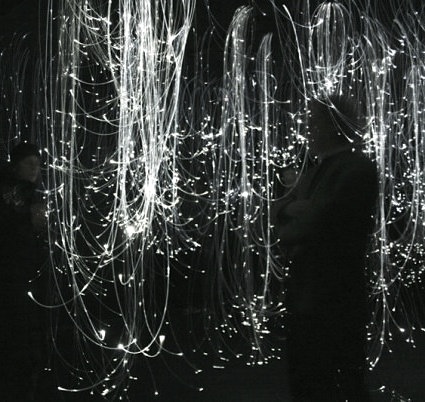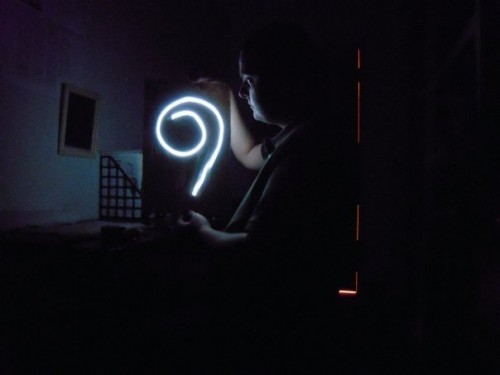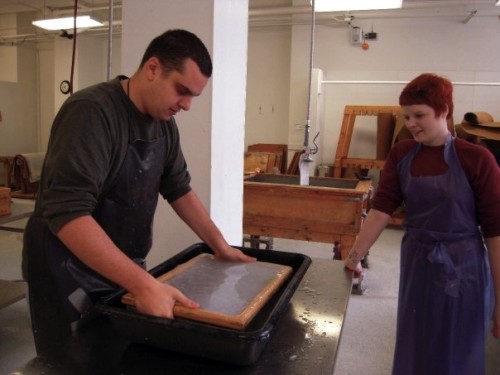InterArts Faculty Spotlight: Paul Catanese
In this blog post, I interview Paul Catanese, a faculty member from the InterArts Department, to get his thoughts on the program…and advice for prospective students.
Along with InterArts, Paul is a hybrid media artist, and President of the New Media Caucus, a College Art Association Affiliate Society. His artwork has been exhibited widely, including at the Whitney Museum of American Art, the New Museum of Contemporary Art, SFMOMA Artist’s Gallery, La Villette-Numerique and Stuttgarter Filmwinter among others. Paul is the recipient of numerous grants and awards, including commissions for the creation of new artwork from Turbulence.org and Rhizome.org.
What is your position at the Interdisciplinary Art Department?
I’m associate professor and associate chair of the department. I teach two classes per semester. In the fall for example, I teach Interactive Media, and the other class tends to change. This semester it’s Thesis, but last fall was Performance in an Artificial Space. Other times it has been The History of New Media.
The associate chair side is mostly administrative things [laughs] that entails coordinating the maps of studios and studio lottery, working on the Graduate Handbook, spearheading recruitment, and things like that…
Let’s go back to classes. What would a day be like as a student in one of your studio classes?
With studio classes, I instruct students on using highly technical tools to make artwork. A class usually involves me demonstrating a technique, which could be computer vision techniques, advanced audio recording, or even building sensor circuits…it really varies from class to class.
[flickr id=”6173457952″ thumbnail=”medium” overlay=”true” size=”original” group=”” align=”none”]
Aside from demos that help students gain technical knowledge, my main goal in class is to get students to see past the technology and use it to tap into content that it is meaningful to them. Learning how the technology works, and being able to show that you can make it, is a very small part in the process. These tools should have a role in creating a context or framework for your ideas.
[flickr id=”6172943311″ thumbnail=”medium” overlay=”true” size=”original” group=”” align=”none”]
What about the history class you mentioned? What is that class like?
In The History of New Media course, I want students to take an active part in history. Some parts of that course involve papers or presentations on a given artist. The assignment I like the most though is the final project, where I ask the students to work in teams and interview artists out in the field who are working with new media. The end result is an interview in the form of a video-documentary – It’s a living history, and it gives students a chance to see that history unfolding and take part in it, which is exciting.
What do you find most exciting about the InterArts program?
The most exciting aspect for me is that InterArts is a three-year program – which is a very specific choice. What it means as a faculty member is that I get to work with students in a graduate context for three years, and that allows real growth. From the time a student comes into the program, it’s amazing to see them change and grow and evolve with their work. You can change a great deal in three years. What blows me away is that transformation. It’s still them at the end of that journey, but utterly transformed.
The MFA is a terminal degree. Thesis then is the culmination of one’s artistic education, and that is more than evident at the Thesis show. I love checking out the show and witnessing students react to their own work. It’s usually right at the show that they realize, ‘I just did this’. And there it is, this gigantic project that took a great deal of work and energy to make – but that exists as evidence of that transformation. That feeling is hard to reproduce…but we do – Every year [laughs].

Nicholas Sagan's "Theory of a Strange Matter" was a prominent interactive installation at the 2010 InterArts Thesis. Thousands of fiber optic strands mapped star systems that viewers could affect with their motions.
There is a sense of unity within each class year in InterArts—a unity that deepens over time. What qualities in prospective students does the department look for that allows this to happen?
I think the most important thing is demonstration of a creative practice. And that takes many forms. It could mean that someone has a strong writing practice, has dedicated years to that form of work, but they’re now hungry to create visuals or sounds from that text. Or it might be someone who has an extensive practice in video that wants to perform – or traditional materials, or even individuals without a background in art – there are many permutations.
What we are really looking for are individuals who can present strong work, strong ideas, and be able to articulate their process. So much about art is being able to speak about your work to a large audience. For the department, we’re looking for prospective students who can demonstrate that they have a dedicated creative practice, and that practice can be expanded with graduate study. It’s not the only criteria we’re looking for, but it’s certainly the biggest.
Some people can demonstrate they have a creative practice right out of undergraduate, and others come to us after years of working outside of school. The great thing is that within a group of people, no one is going to have the same background – technical, conceptual, or otherwise. What they will have in common is the experience of knowing what it takes to maintain a strong practice. That knowledge is a bond between students, and it allows them to network, and build professional relationships that will carry with them for the rest of their career in this new phase of their education.
What piece of advice could you give to a prospective student considering InterArts?
I think you should visit. If InterArts is a program you’re interested in, you should come here, check it out, and meet the students already in the program. The experiences of the InterArts students will be the best indicator of whether or not the rogram is right for you. It’s also a way of figuring out if these are the people you want to spend years working alongside and be colleagues with. We have a very active, collegial, and nurturing environment, and its good to see that first hand to figure out if its somewhere they could picture themselves studying and making artwork.
And of course, I hope they would be!
 One of Paul’s experiments with electronics and paper making
One of Paul’s experiments with electronics and paper making
For more information, visit Paul’s website at www.paulcatanese.com, as well as the New Media Caucus website.

